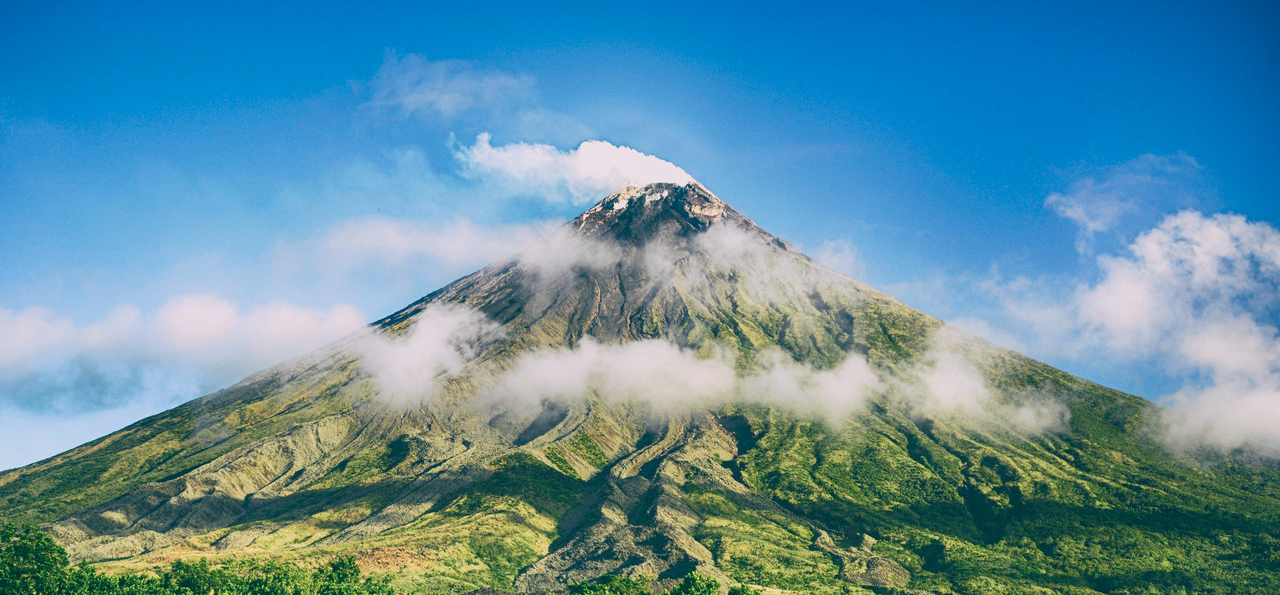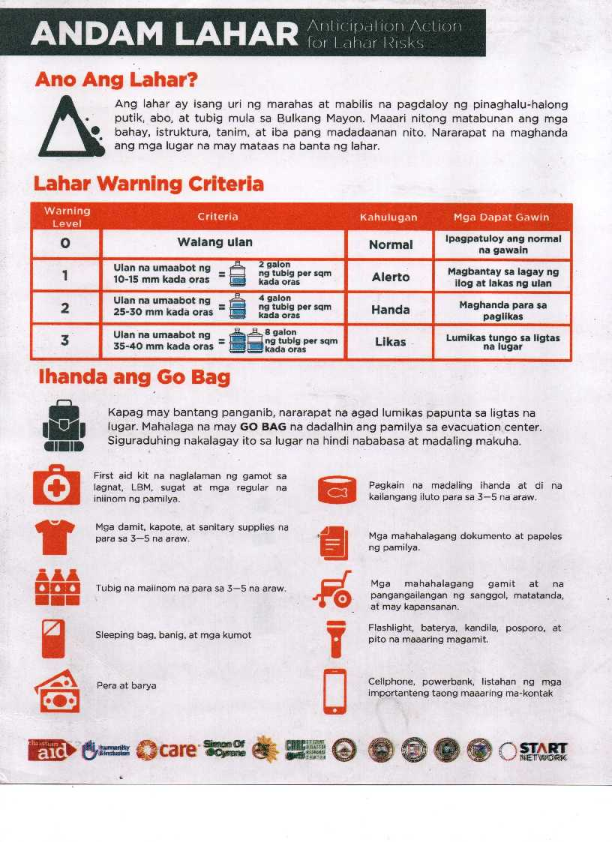

Volcanic Eruption
The first documented eruption of Mayon Volcano was in 1616, and has erupted a total of 52 times since, with the last eruption on 2018. The predominant type of eruptive activity is characterized by one or a combination of lava fountaining, generation of pyroclastic and lava flows and formation of tall eruption columns. Most eruptions evolve from discrete explosions to near continuous lava fountaining; other eruptions involve short periods of inactivity within one eruptive episode. Some precursors associated with Mayon Volcano eruptions are: increased background seismicity levels, change in color and increase in volume of steam emission, presence of crater glow, rumbling sounds and fissuring at or near the summit.
Contrary to popular belief, Mayon does not erupt every 10 years and there is no evidence supporting this concept. The nature of Mayon Volcano’s eruptions are different in types and magnitude and can be described as minor explosive, major explosive or major non-explosive. Minor explosive eruptions are characterized by minor ash explosions. The duration of each eruption period usually lasts from one day to several days.
Major eruptions are three different types: Plinian, Vulcanian and Strombolian. Each styles have its own characteristics and degree of violence. If the magma about to erupt is volatile-rich, then an explosive eruption is to be expected. Degassed or volatile-poor magmas favor non-explosive eruptions. Plinian and Vulcanian types are explosive while strombolian eruptions are non-explosive. A single eruption may exhibit only one eruption style or may have two or three types throughout the duration of the event. More often, Mayo’s eruptions are Vulcanian in nature. Except for the Plinian eruption in 1814, all other historical eruptions have been Vulcanian or Strombolian or a combination of both. There are two common sequences exhibited by Mayon during its eruptive stage: One starting with explosive ejection of ash and pyroclastic flows followed by lava flows (1968 eruption) and the other with initial non-explosive extrusion of lava culminating in violent ejections of pyroclastic flows (1984 eruptions). Solely strombolian activities usually starts with minor ash ejections and end with “quiet” lava effusion as in the 1978 eruption.
Strombolian Eruption
The most distinctive feature of this eruption styles is the quiet extrusion of lava from Mayon’s summit crater or from point in the summit. This type produces discrete but minor explosions of ash and incandescent coarse pyro clasts, particularly volcanic bombs. Such explosions produce a spectacular display of fire fountaining. During the 1978 eruption, hot molten lava continuously but slowly poured out from the crater and cascaded downward to flow along the gully towards Camalig. This lava flow then formed an elongated (4.2 Km) and incandescent stream of molten volcanic rock material 20m thick and 250m wide at its front. The first phase of the 1984 activity was a fairly strong Strombolian type, characterized by a small pyroclastic flow events followed by strong lava effusion. The 1984 lava flow lies alongside the 1968 and 1978 lava flows.
Vulcanian Eruption
This is the most common type of Mayon Volcano eruption. It often produce a moderately violent but intermittent unsustained explosions involving ash, lapilli, blocks and bombs, producing pyroclastic flows and fine tephra fall materials; an eruption column with a distinctive “cauliflower” shape may be visible from a distance. Vulcanian eruptions may characterize a single eruption, or it may either precede or follow a Strombolian event. During the 1968 eruption, the first phase was Vulcanian in nature. Pyroclastic flows swiftly cascaded down towards the lower slopes near the municipalities of Camalig and Guinobatan. In 1984, the second phase of the eruptive period was also Vulcanian. Voluminous pyroclastic flows were deposited towards Legaspi and Sto. Domingo.
Plinian Eruption
This eruption is the most violent of all three types. It is characterized by extreme violent and continuous sustained ejection of pyroclasts, mostly volcanic ash and lapilli particles, with attendant formation of a tall umbrella-like eruption column. The eruption of Mayon in 1814 could be classified as a major Plinian type.
Precursory Signs:
In general, the following are the precursory signs that usually precede Mayon Volcano’s activities:
- Increase in seismicity level
- Inflation and tilting of the volcano slopes near the crater
- Change in color of steam emission from white to brown or light gray due to presence of ashes
- Change in the volume of steam emission due to increase in temperature
- Presence of crater glow with increasing intensity due to presence of magma
- Rumbling and other subterranean noises
- Fissuring rockfalls and landslides at or near the crater due to pressure exerted by rising magma
- Unusual animal behavior
Hazards Associated with Mayon Volcano Eruption
Volcanic hazards vary greatly in type, areal extent, duration and destructive potential. The associated hazards are a consequence of Mayon’s three different eruption types discussed previously. In general, “small” and non-explosive eruptions produce few hazards while “big’ eruptions have many associated hazardous phenomena. These phenomena pose serious threats to life and poverty in varying degrees in areas around the volcano. The associated hazards due to eruptive products and areas vulnerable to such hazards.
Hazards from Mayon can be classified into two broad types:
- Flowage Hazards (ground-huggers)
- Lava flows
- Pyroclastic flows (pyroclastic density currents)
- Lahars
- Non-flowage Hazards
- Ballistic fragments
- Large-tephra fall
- Ashfall
Lava Flow
Lava flows are relatively large, coherent and elongated streams of incandescent molten materials that usually ooze non-explosively from the volcano’s summit crater or from a point near the summit that cascade along ravines and gullies. Lava flows are extremely hot (about 1000 degrees centigrade) when they leave the vent. They cascade down along the upper cone but move very slowly upon reaching the basal slopes. Their moderately high viscosity makes them move slowly (a few meters per hour), this characteristic viscosity also tends to retard the spreading out of the flows far from their source. The farthest distance reached by a Mayon lava flow is just six km from the volcano crater.
Pyroclastic Flow
The term “pyroclastic” – (now called pyroclastic density current) is derived from the Greek words pyro (fire) and klastos (broken) – describes materials formed by the fragmentation of a “new” magma and solidified “old” volcanic rock by explosive volcanic eruptions.
Pyroclastic flows, sometimes called ash flows or nuees ardentes (French for “glowing clouds”) are superhot, often incandescent and turbulent blasts of volcanic fragments (boulders, pebbles, sand and dust) and hot gasses that sweep along close to the ground at hurricane speeds, sometimes as great as 500 kph. Being ground-huggers, they are horizontally directed and devastate large areas along topographic depression and gullies through which they encroach. They are fatal to nearly all life and property in the affected area.
Pyroclastic flows issues from Mayon Volcano summit crater and are commonly produced during explosive Vulcanian type eruptions either by backfall (collapse) of pyroclastic materials from a tall eruption column or by boiling-over directly from its vent. These ground-huggers pyroclastic and gas mixtures tend to follow existing gullies or crevices the main flow. This ash cloud can be easily drifted by the prevailing surface windstream. The flowing hot debris stops when enough gas has been lost from the suspension, leaving a thick but loose deposits consisting of a mixture of boulders and ashes.
Pyroclastic flows are extremely hot (up to 1000 degrees Centigrade) upon leaving the vent but are “cooler” when they reach downslope areas. They still remain hot, even incandescent or molten when deposited.
Tephra and Ballistic Fragments
Tephra consists of explosively ejected slots of either new incandescent magma or fragments of older solid rock. These particles are explosively hurled into the air from the crater by the force of an erupting volcano. It is synonymous with the word pyroclastic. Tephra particles are of various sizes – ash (less than two mm in size), lapilli (two to 64 mm in size), bombs (greater than 64 mm in sizes). Lapilli and bombs are kinds of large tephra.
Ashfall
Volcanic ash is a tiny or powdery tephra. It is produced when rising magma in upper conduit is fragmented or pulverized due to expansion of compressed gasses. The pulverized materials are then blasted upward from the crater during explosive eruptions.
Because of its small size, ash can be hurled high upward (as high as 25 km from the crater), and can remain airborne in the atmosphere for prolonged periods. It can also be carried by prevailing winds farther than any volcanic material. It is the most common hazard from Mayon. Vertical ash ejections often accompany pyroclastic flows.


*IEC on Ashfall by Phivolcs
Lahar
Lahars (an Indonesian term), sometimes called mudflows or volcanic debris flows, are flowing mixtures of volcanic debris and water. Geologists classify lahars into two types: primary or hot lahars which are associated directly with volcanic eruptions and secondary or cold lahars which are caused by heavy rainfall. Both types occur in the area surrounding Mayon Volcano.
Lahars from Mayon originate from its summit crater but from the upper and middle slopes of the volcano. Lava and pyroclastic materials perched on the steep slopes are eroded and then mobilized by heavy rains, thus causing a debris-water mixture (like the consistency of wet concrete) to cascade and flow downslope of the volcano. Lahars usually follow pre-existing gullies and ravines. Upon reaching the lower slopes, they spread out and leave thick and widespread deposits.
Depending on the slope on which they flow, lahars span a wide range of velocities and dimensions. In Cotopaxi Volcano (Ecuador 1877), lahars traveled 300 kms at an average speed of 27 kph. The 1980 eruption of Mt. St. Helens triggered lahars that traveled for 35 kms as fast as 120 kph. In 1985, melting of snow and ice by an eruption of Nevado del Ruiz in Columbia triggered a gigantic lahar that flowed along a major river to engulf the town of Armero (50 kms from the crater) and bury 20,000 residents in just less than an hour.
*IEC on Lahar by APSEMO

Source: Mayon Operation, PHIVOLCS

Tropical Cyclone

Earthquake

Tsunami

Landslide

Flooding







